Home >> Electricity, concepts & units 1
charge |
Charge (symbol Q)
On the sub-atomic level we have a unit of charge of 'e' , the charge on the electron. This has the value −1.602×10-19C. Similarly, a proton has a charge of +1.602×10-19C .
The macro unit of charge in electricity is the Coulomb (C). It is quite a large unit and has approximately the same charge as 6.2×1018 electrons(or protons).
By definition the Coulomb is defined as:
the charge passing an arbitrary fixed point when a current of 1 Amp. flows for 1 sec.
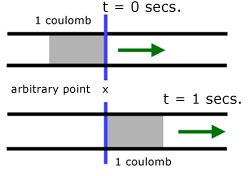
Current (symbol I)
Electric current can be thought of as a flow of charged particles. In the normal case, when charge flows through wires these particles are electrons. However, when current flows in a vacuum, a solution or a melt, the charge carriers are ions. In semiconductors the charge carriers are exotic particles called 'holes'.
By definition the Ampere (A) is defined as:
the current passing an arbitrary fixed point when a charge of 1 Coul. flows for 1 sec.
Since,
amount of fluid = rate of flow x time
by analogy,
charge = electric current x time
(Coulombs) = (Amperes) x (seconds)
Q = It
Potential Difference (symbol V)
Potential difference is short for potential energy difference. Our definition of the volt relates charge and the work needed to move that charge between two points.
In our definition of the volt, the charge is 1 Coulomb and the work done is 1 Joule.
Hence the definition :
Two points A & B are at a potential difference of 1 volt if the work required to move 1 coulomb of charge between them is 1 Joule.
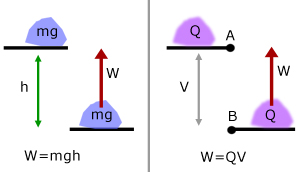
A simple analogy is gravity. Compare the energy difference between a rock at the bottom of a cliff and the energy in moving it to the top of the cliff. An energy difference exists between the top of the cliff and the bottom. The amount of energy difference depends on the size of the rock and the height of the cliff (P.E. = mgh) .
In our analogy, height relates to potential difference and rock weight relates to the amount of charge. Work is done on the rock against the force of gravity. Work is done on the charge in moving it against an electrostatic force.
The volt has unit of joules per coulomb (JC-1 ).
We now have an equation linking work/energy W, charge Q and potential difference V :

work = charge x potential difference
(Joules) = (Coulombs) x (volts)
Resistance (symbol R)
By definition, the electrical resistance (R) of a conductor is the ratio of the p.d. (V) across it to the current (I) passing through it.
![]()
From this equation, by making each quantity unity, we define the Ohm:
The resistance of a conductor through which a current of 1 ampere flows when a p.d. of 1 volt exists across it.
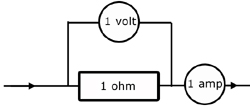
Note in the diagram, the voltmeter is in parallel with the resistance, while the ammeter is in series.
Some conductors/devices have variable resistances which depend on the currents flowing through them.
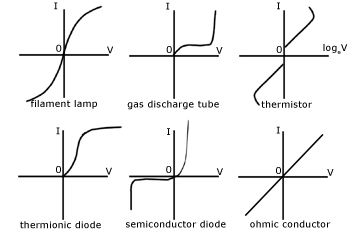
These are all non-ohmic conductors except for the bottom right graph. Ohmic conductors are all metals and follow Ohm's Law.
Ohm's Law
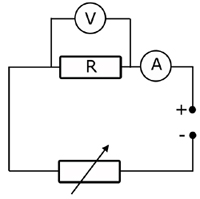
The current through a resistor is varied, while the p.d. across it is measured. The graph of V against I is a straight line through the origin.
Hence,
![]()
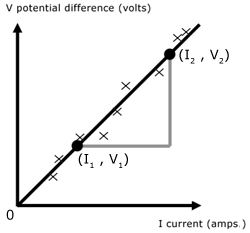

Ohm's law states:
The current through a conductor is directly proportional to the p.d across it, provided physical conditions* are constant.
*eg temperature
this week's promoted video
[ About ] [ FAQ ] [ Links ] [ Terms & Conditions ] [ Privacy ] [ Site Map ] [ Contact ]
